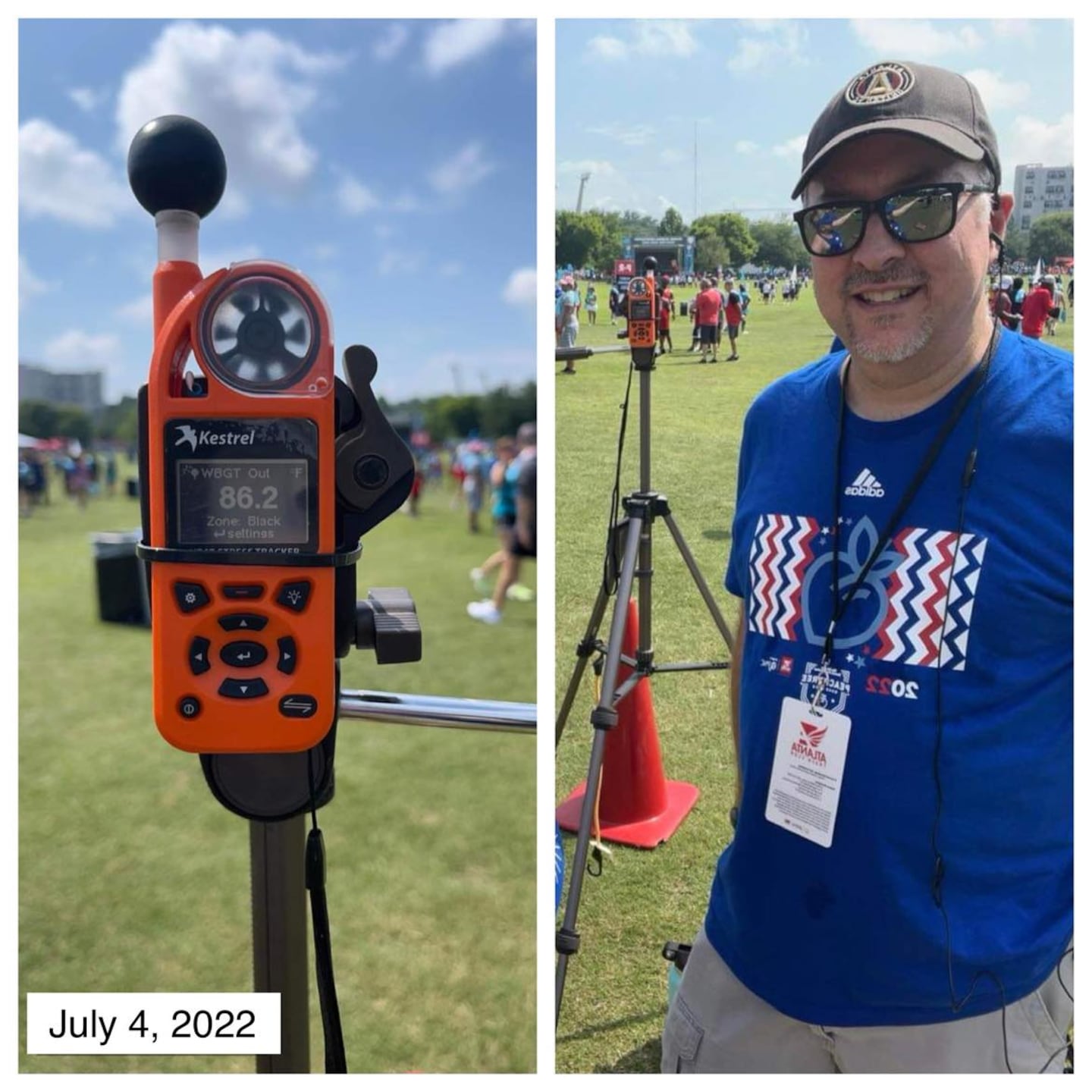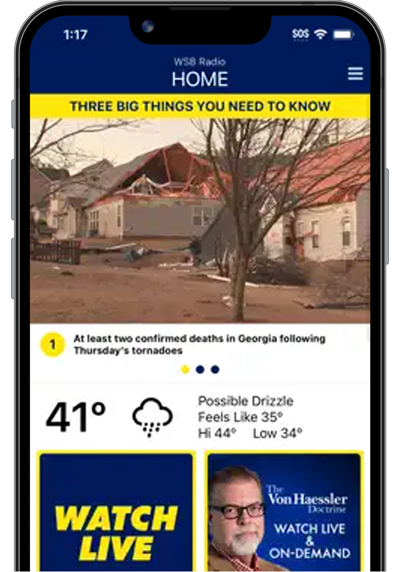I sat down with the Atlanta Track Club’s CEO Rich Kenah to discuss how runners and walkers can prepare for this year’s AJC Peachtree Road Race! Who else is taking on the 10k?! 🍑 🏃♀️
Posted by Christina Edwards on Thursday, June 29, 2023
The Peachtree Road Race is an event that many Atlanta residents -- myself included -- look forward to each year.
But in addition to training for the distance, walkers and runners should also train for the heat and humidity.
While 6.2 miles on a treadmill may be tolerable for many athletes, it’s a different story covering the distance on Peachtree Road on the morning of the 4th of July.
Below is my interview with Rich Kenah, CEO of the Atlanta Track Club.
Q&A with Atlanta Track Club CEO Rich Kenah
Christina Edwards (CE): I am planning on running the course on Tuesday morning and so that’s what’s inspiring me to reach out and talk with you. My first race was in 1999. My second was sometime in 03, the third one was 04 and then finally joined again last year. Usually they’ve been sunny with temperatures in the 70s.
(CE): So my first question for you is tell me about historical Peachtree Rd. races. What were the warmest races on record for us between 6:00 AM and 11:00 AM?
Rich Kenah (R.K): So as as a meteorologist you’ll understand this as good as anybody. Sometimes it’s not necessarily the temperature that that drives the the experience for the participant is that combination of heat and humidity. So, so the, I believe the warmest start time we’ve we’ve had that book is around 78 degrees and and that I think we peeked out. I have to look at our records, but I think around 88 or 89.
(R.K): But I’m not sure that tells the full story.
(CE): But 88 to 89 degrees while the course is running, It’s before the 11:00 AM cut off.
(R.K): That’s correct.
(CE): That’s intense. That’s intense. So do you happen to know when was the rainiest Peachtree Rd. race?
(R.K): Well, in recent times we we had a quite a rainy day in 2015. As a matter of fact, that’s the only year in the history of the Peachtree where we have had a lightning strike during the operational period.
(CE): So what would happen if lightning was spotted or Thunder was heard while running the course?
(R.K): So we learned a lot from 2015. We had an operational plan that had had never actually been executed around the severe weather. So in short we will be working with the local meteorologists like yourself on the race morning and and looking for any hint, any possibility of lightning. If we have a significant possibility we would hold and not even start the race until it passed.
(R.K): That likelihood went down, but what we learned from 2015 is that we can successfully postpone or halt the operation of the race. So we have a plan where we will move those who have not started yet into ground level parking decks around the start line, Lenox and Phipps.
(R.K): And in the finish line area in Piedmont Park, we will move those folks into sheltered areas, Grady Midtown High School being one of them. And then once the lightning has cleared -- and we use eight mile radius of the course -- then we will wait 30 minutes and restart.
(CE): Let’s say I’m at mile 2 1/2 and lightning was seen, thunder was heard, participants were on the courses. I imagine -- OK, we have a business nearby. Everybody get in 30 minutes, we’ll wait it out?
(R.K): That’s correct. And and with technology, we have found that more people run with their phones than ever before.
(R.K): So we will text message every participant and every volunteer if that were to happen. So you would receive messages directly from us as well as when you got to the nearest hydration station that you would receive the latest update from there, which would advise you at that point to find shelter and continue at your own risk.
(CE): You have briefly touched on it. Basically you go to the hydration stations, there are updates both visuals as well as telling us audibles as we grab our cups of water. The system starts off with green, yellow, red and then black. Tell us about that system.
(R.K): Sure. So it’s it’s called the Event Alert Systems or EAS program. And we use that color-coded tree to communicate just visually with everybody, of course, volunteers and participants alike. So conditions are great. It’s going to be 65 degrees, no humidity, a perfect day.
(R.K): If we started to get warm we would move up to yellow -- that is when race conditions are starting to to get a little challenging. Make sure that you hydrate and be aware of the conditions that are on the course. Once you get to red flag conditions, that’s dangerous for those with any conditions or anyone coming into the race with conditions -- that would indicate they should not be out exercising in very hot, very humid weather - we want those people to know. And then when you get to black -- and to that point, if we had a lightning strike -- then we would need to postpone.
(CE): OK, once we move to a Black Flag that means that the race has been cancelled and it would not restart. And just a hypothetical, weather-wise, what would be a Black Flag event? Would that be ongoing severe weather including thunder and lightning?
(R.K): Heat and humidity -- such that we were seeing significant medical issues on course and in our medical tents -- that we did not feel that we could continue to provide race support. Now in those scenarios you still have thousands of people out there on the course.
(R.K): So it’s very important that people not only look at the flag but look and listen to the messaging that we are providing -- that will help you determine what your next step should be.
(CE): I’ve been doing heat training in addition to the distance training. But for those who perhaps maybe have been going out once a week or I’m just gonna walk it, walking will be fine. What should all athletes, people who are walking, running, everybody who is participating, everybody who is going to step out on the course -- what should everybody know for race day for preparing for the heat and humidity?
(R.K): They should know spend these next few days acclimating to heat and humidity. So the great news is that we had a a a relatively mild spring and and we have not really experienced the heavy heat and humidity that that the 4th of July is known for.
(R.K): So I would encourage people to get out around the morning time where you will be out on the 4th of July, get used to that heat humidity.
(R.K): Waiting until race morning or even the night before to start to hydrating is too late, so start to hydrate now and then.
(R.K): Last and certainly not least is to dress appropriately.
(CE): And when you say dress appropriately, that’s common sense. It’s that those dark colors are going to absorb the sunlight. It’s going to make it feel hotter to your skin, one of one of where lighter colors, but also which fabrics would be better than others?
(R.K): So running tech fabrics are best. Stay away from sort of the old school heavy cotton, those those materials that are not as breathable, they’ll keep that heat in and you’ll overheat more quickly.
(R.K): And we’ve got 10 hydration stations on the course, every mile on both sides of the street. In addition to that, we have water sprays on the course. So we encourage those who feel as if they are getting warm -- overheating -- to utilize the the hydration and the opportunity to cool their body down through those water sprays.
(CE): And just in case, there are medical tents along the course as well?
(R.K): What we have on the course is significant medical response. Our EMTs use bikes so that they can move up and down the course as quickly as possible. If you are experiencing heat related illness and you are near a hydration station, you can certainly let the emergency medical personnel that are near that station know that you’re you’re in trouble and they will take care of you appropriately.
(R.K): We at the Atlanta Track Club have have paid attention to heat related challenges.
(R.K): At the Peachtree, for a long time we have some of the best trained medical personnel in and around this race. You know, because of the history of the Peachtree, this is the 54th running so races around the world ask us how we manage heavy heat and humidity because this is what we do.
(R.K): And I would add that we we use wet bulb temperatures to help drive the changes in our flagging system and not just heat or humidity. So it’s something that we keep an eye on and we’ll keep an eye on every hour, every day between now and the 4th and then throughout the morning on the 4th.
(CE): Excellent. And I I happened to meet one of the volunteers who was running the wet bulb thermometers out in Piedmont Park last year, it was really neat to see the technology and really neat to see them relay the info to you in real time.
(R.K): It’s amazing what technology can do as as it helps inform a safe, fun morning for everybody at the Peachtree.
Have a Happy and Safe 4th of July! Share Your Peachtree Road Race Photos With Me!
Facebook: Christina Edwards WSB
Twitter: @ChristinaWSBwx
©2022 Cox Media Group















